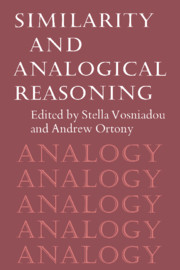Book contents
- Frontmatter
- Contents
- Preface
- List of contributors
- Similarity and analogical reasoning: a synthesis
- Part I Similarity and the structure of concepts
- 1 Similarity, typicality, and categorization
- 2 Similarity and decision making
- 3 Intraconcept similarity and its implications for interconcept similarity
- 4 Two-tiered concept meaning, inferential matching, and conceptual cohesiveness
- 5 From global similarities to kinds of similarities: the construction of dimensions in development
- 6 Comments on Part I: Psychological essentialism
- Part II Analogical reasoning
- Part III Similarity and analogy in development, learning, and instruction
- Afterword: Comments on Parts I, II, and III: A framework for a theory of comparison and mapping
- Name index
- Subject index
2 - Similarity and decision making
Published online by Cambridge University Press: 22 October 2009
- Frontmatter
- Contents
- Preface
- List of contributors
- Similarity and analogical reasoning: a synthesis
- Part I Similarity and the structure of concepts
- 1 Similarity, typicality, and categorization
- 2 Similarity and decision making
- 3 Intraconcept similarity and its implications for interconcept similarity
- 4 Two-tiered concept meaning, inferential matching, and conceptual cohesiveness
- 5 From global similarities to kinds of similarities: the construction of dimensions in development
- 6 Comments on Part I: Psychological essentialism
- Part II Analogical reasoning
- Part III Similarity and analogy in development, learning, and instruction
- Afterword: Comments on Parts I, II, and III: A framework for a theory of comparison and mapping
- Name index
- Subject index
Summary
Our goal is to extend certain theoretical notions about similarity – particularly notions about similarity to prototypes – to studies of decision making and choice. For the past decade, the psychology of decision making has been dominated by the brilliant research of Daniel Kahneman and Amos Tversky. Although Kahneman and Tversky (hereafter K & T) have contributed greatly to this area, their research seems to be swimming against the strongest current in contemporary psychology in that it is not primarily concerned with issues of representation and process. We think that this neglect of a computational perspective has limited the generalizations that K & T and their followers have drawn from studies of decision making. We will support our position by showing that an explicit model of similarity and decision making promotes new generalizations and suggests new insights about some of K & T's best-known studies.
In particular, such a model will allow us to specify the factors that control the phenomena that K & T have uncovered, thereby permitting us to determine the conditions under which the reasoning illusions they describe will arise. This is in contrast to K & T's approach of simply demonstrating the phenomena, with no attempt to delineate boundary conditions. Our approach should also enable us to connect the areas of decision and choice to recent advances in the theory of knowledge representation.
- Type
- Chapter
- Information
- Similarity and Analogical Reasoning , pp. 60 - 75Publisher: Cambridge University PressPrint publication year: 1989
- 18
- Cited by



